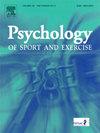对处方和自我选择的相同抵抗运动的情感反应
IF 3.3
2区 心理学
Q2 HOSPITALITY, LEISURE, SPORT & TOURISM
引用次数: 0
摘要
允许个人自行选择有氧运动已被证明可以增加乐趣,但关于自行选择抗阻运动如何影响乐趣的了解较少。受试者到实验室进行三次膝关节伸展,每次间隔七天。在第一阶段,受试者被要求自行选择运动负荷、重复次数和两组之间的休息时间。第二阶段的目的是确定个人在自选负荷下可以重复多少次,并改变运动负荷以降低个人回忆起他们在访问1时自选的内容的可能性。第三个阶段包括完成与第一个阶段相同的练习,只是个人被规定了练习。在每组结束时,参与者被要求对他们的运动引起的感觉、感觉唤醒、不适和储备重复进行评分。共有27只个体(17只雄性,10只雌性)完成了这项研究。平均而言,个体在自愿任务失败的情况下进行了2.8(5.9)次重复,这相当于完成了88.3(28.5)%的自我选择负荷本可以完成的重复。自我选择的锻炼时段产生更大的情感反应(2.6 vs. 1.9;BF10 = 10.516),感觉觉醒(3.6 vs. 3.1;BF10 = 89.157),不适感(3.7 vs. 2.8;BF10 = 20.350)。允许个人自我选择他们的抗阻运动方案增加了乐趣,这可能有助于增加长期坚持。本文章由计算机程序翻译,如有差异,请以英文原文为准。
Affective responses to identical resistance exercises that are prescribed and self-selected
Allowing individuals to self-select their aerobic exercises has been shown to increase enjoyment, but less is known on how self-selecting resistance exercise impacts enjoyment. Individuals came to the laboratory for three sessions of knee extensions each separated by seven days. During the first session, individuals were instructed to self-select the exercise load, number of repetitions, and the rest period between sets. The second session was designed to determine how many repetitions individuals could perform at their self-selected load, and to vary the exercise loads to reduce the likelihood that individuals could recall what they self-selected on visit 1. The third session involved completing the same exercise that was performed on session 1, except the individuals were prescribed the exercise. At the conclusion of each set, individuals were asked to rate their exercise induced feelings, felt-arousal, discomfort, and repetitions in reserve. A total of 27 individuals (17 males, 10 females) completed the study. On average, individuals exercised 2.8 (5.9) repetitions short of volitional task failure, which corresponded to performing 88.3 (28.5) % of the repetitions that could have been completed with the self-selected load. The self-selected exercise session resulted in greater affective responses (2.6 vs. 1.9; BF10 = 10.516), felt-arousal (3.6 vs. 3.1; BF10 = 89.157), and discomfort (3.7 vs. 2.8; BF10 = 20.350) as compared to the prescribed exercise session. Allowing individuals to self-select their resistance exercise protocols increased enjoyment, which may help to increase long-term adherence.
求助全文
通过发布文献求助,成功后即可免费获取论文全文。
去求助
来源期刊
CiteScore
6.40
自引率
5.90%
发文量
172
审稿时长
69 days
期刊介绍:
Psychology of Sport and Exercise is an international forum for scholarly reports in the psychology of sport and exercise, broadly defined. The journal is open to the use of diverse methodological approaches. Manuscripts that will be considered for publication will present results from high quality empirical research, systematic reviews, meta-analyses, commentaries concerning already published PSE papers or topics of general interest for PSE readers, protocol papers for trials, and reports of professional practice (which will need to demonstrate academic rigour and go beyond mere description). The CONSORT guidelines consort-statement need to be followed for protocol papers for trials; authors should present a flow diagramme and attach with their cover letter the CONSORT checklist. For meta-analysis, the PRISMA prisma-statement guidelines should be followed; authors should present a flow diagramme and attach with their cover letter the PRISMA checklist. For systematic reviews it is recommended that the PRISMA guidelines are followed, although it is not compulsory. Authors interested in submitting replications of published studies need to contact the Editors-in-Chief before they start their replication. We are not interested in manuscripts that aim to test the psychometric properties of an existing scale from English to another language, unless new validation methods are used which address previously unanswered research questions.

 求助内容:
求助内容: 应助结果提醒方式:
应助结果提醒方式:


